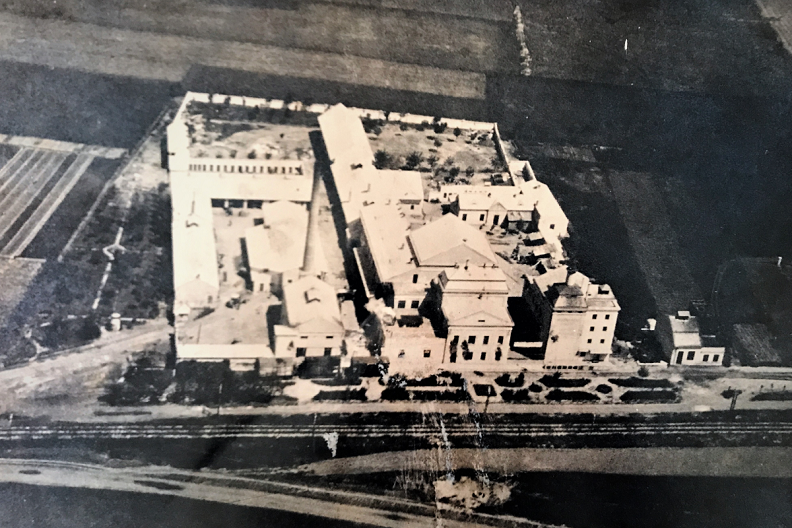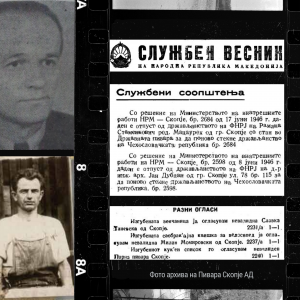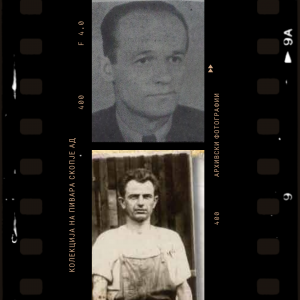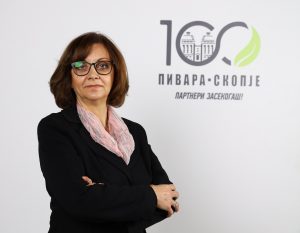
PIVARCI WORKED, BUT ALSO LIVED ON THE PIVARA SKOPJE FACTORY PREMISES
Poured from
Vasilka Dimitrovska, M.Sc
Alexander Madzovski
HAEMUS – Center for scientific research and promotion of culture
The soul of a company such as Pivara Skopje AD is made by its people, and Pivarci have been living as one big family since the company was founded. Most of them are descendants of the people who created, built, nurtured and continued the tradition of brewing beer, upgrading the image they themselves grew up with. It is a little-known fact that from the very founding of Pivara Skopje in 1922, until the beginning of the 1990s, a large number of employees lived in the company’s own circle. Here they got a job, fell in love, started families, settled down and spent most of their lives.
 The archival research, which we carried out in order to faithfully convey the history of the company, revealed that its founders sent a request to the City Mayor back then in order to obtain an approval for an installation of a brewery in the part of the town called Kjeramidnica, where they had already purchased land of 32,347 m2, next to the railway line Skopje-Nis. Back in those years this was a really large piece of land where the factory, administrative offices, own stables were built, as well as facilities for the employees’ living quarters to be in use later for decades. These residences were originally intended mainly for management personnel. After the Second World War, twelve families of workers and employees of the company were housed in the buildings. The archives witness and confirm the case of Ramana Stamenkovic from Skopje, born Matsaurek. From an announcement published in the Official Gazette from 1946, we learn that during the issuance of a permit to re-acquire Czechoslovak citizenship, by the Ministry of Internal Affairs of the People’s Republic of Macedonia, she was registered with a residence address at the State Brewery, as the Pivara was then called.
The archival research, which we carried out in order to faithfully convey the history of the company, revealed that its founders sent a request to the City Mayor back then in order to obtain an approval for an installation of a brewery in the part of the town called Kjeramidnica, where they had already purchased land of 32,347 m2, next to the railway line Skopje-Nis. Back in those years this was a really large piece of land where the factory, administrative offices, own stables were built, as well as facilities for the employees’ living quarters to be in use later for decades. These residences were originally intended mainly for management personnel. After the Second World War, twelve families of workers and employees of the company were housed in the buildings. The archives witness and confirm the case of Ramana Stamenkovic from Skopje, born Matsaurek. From an announcement published in the Official Gazette from 1946, we learn that during the issuance of a permit to re-acquire Czechoslovak citizenship, by the Ministry of Internal Affairs of the People’s Republic of Macedonia, she was registered with a residence address at the State Brewery, as the Pivara was then called.
 Velko Nestorovski, the son of Pavle Trajanovski, is also mentioned in these times. Pavle was one of the first employees of the factory. He was a mechanical locksmith by profession, but being a diligent, smart and capable worker, he reached the position of technical director, earning the nickname “boss”. As Velko remembers, back in 1919 when the Czechs decided to build the factory, they called on Pavle to help them find a suitable location. When the plant was put into operation, he worked as the head of the mechanical department, and in the meantime the Czechs helped him to continue his education in the mechanical and electrical profession.
Velko Nestorovski, the son of Pavle Trajanovski, is also mentioned in these times. Pavle was one of the first employees of the factory. He was a mechanical locksmith by profession, but being a diligent, smart and capable worker, he reached the position of technical director, earning the nickname “boss”. As Velko remembers, back in 1919 when the Czechs decided to build the factory, they called on Pavle to help them find a suitable location. When the plant was put into operation, he worked as the head of the mechanical department, and in the meantime the Czechs helped him to continue his education in the mechanical and electrical profession.
“Our family lived in the factory,” Velko recalls. “The families of the employees of Pivara Skopje were very good friends among themselves. Usually on the 1st of May, all the Pivarci gathered and made great parties, locally called “gezminjas”.
 According to the memories of the old Pivarci, the residences around Pivara were in an oblong building, built even before the Second World War. Next to it were the old sheds where the malt was roasted. The building had two floors and faced the small narrow alley that was located between the Brewery and the “Europa” factory. In the lower part Pivara also had its own shop and it was common to see the then popular cars “Fico” and “Tristac” parked nearby and people loading several crates of “Skopsko” for the holidays. Up to five families lived in the building, three families on the upper floor, and two families on the lower floor. This is confirmed by the memories of Susana Dimovska, who has been part of the financial sector of Pivara Skopje for more than 30 years. She followed the footsteps of her father, who was also an employee of the company. Her family moved to Skopje from Nova Gradishka, Croatia before the First World War. When the war started, the family returned to their homeland, and after it ended, they returned to Skopje, where they stayed permanently. Her grandfather Stijepan Gogic immediately got a job in the new brewery’s taproom, where he stayed until his retirement in 1963, with forty years of work experience. At the time of his employment, he moved into the same oblong building. He started a family here and all his eight children who grew up in the circle of the Pivara factory, later got a job here.
According to the memories of the old Pivarci, the residences around Pivara were in an oblong building, built even before the Second World War. Next to it were the old sheds where the malt was roasted. The building had two floors and faced the small narrow alley that was located between the Brewery and the “Europa” factory. In the lower part Pivara also had its own shop and it was common to see the then popular cars “Fico” and “Tristac” parked nearby and people loading several crates of “Skopsko” for the holidays. Up to five families lived in the building, three families on the upper floor, and two families on the lower floor. This is confirmed by the memories of Susana Dimovska, who has been part of the financial sector of Pivara Skopje for more than 30 years. She followed the footsteps of her father, who was also an employee of the company. Her family moved to Skopje from Nova Gradishka, Croatia before the First World War. When the war started, the family returned to their homeland, and after it ended, they returned to Skopje, where they stayed permanently. Her grandfather Stijepan Gogic immediately got a job in the new brewery’s taproom, where he stayed until his retirement in 1963, with forty years of work experience. At the time of his employment, he moved into the same oblong building. He started a family here and all his eight children who grew up in the circle of the Pivara factory, later got a job here.
In the 60s, wanting to accommodate as many employees as possible, the company began to think about issuing the so-called social housing and through its internal newsletter “Pivarski Zbor” (eng. Pivara Gazzette) taught its workers how to apply for a loan from the Housing Construction Fund. As soon as one of the families who lived in the oblong building got an apartment, another moved in its place. That cycle of moving in and out continued until the end of the 80s, when the building had to be demolished, and a new administrative building built instead.
Based on this tradition, the team of Pivara Skopje AD continues to live and function as one big family. Because that’s the only way a true success can be guaranteed – with mutual respect, care and love. Together in challenges, together when we toast celebrating successes!
The text is adapted and edited from the original research project of HAEMUS entitled “Study on the history of Parnata Pivara AD Skopje”, commissioned and supported by Pivara Skopje AD.
Photo: Archive of Pivara Skopje AD
Archive source: NUB “St. Kliment Ohridski” – Skopje









